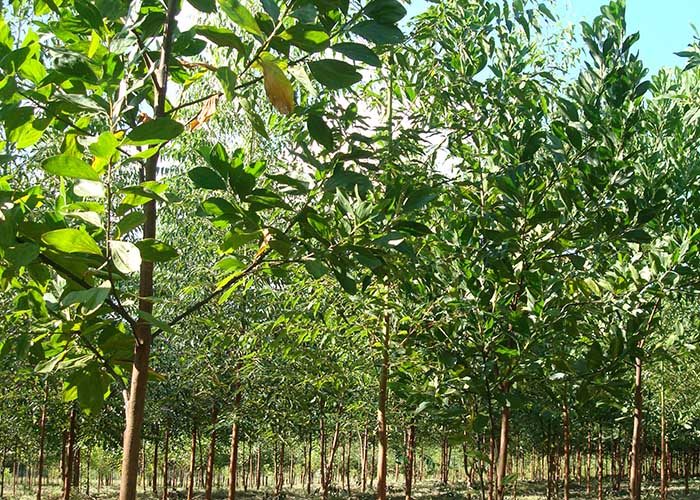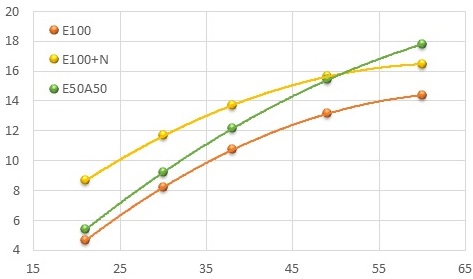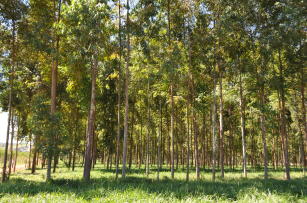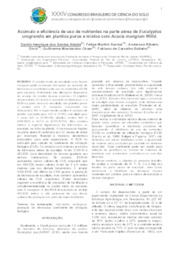Intercropping leguminous plants with eucalyptus eliminates the need for nitrogen fertilization. That is what was demonstrated by a study conducted at Embrapa Agrobiology's experimental field (Seropédica, RJ). The scientists analyzed the impact of the leguminous tree Acacia mangium in eucalyptus forest plantations. Timber production was similar to one obtained from a fertilized monoculture. The savings in fertilizers totalled around R$ 500 per hectare, considering an application of 100 kilos of nitrogen per hectare in the plantations. “When one combines these two species, there is a lower cost of implementation and an increase in biomass production and in the diversity of living beings in the soil”, explains Guillermo Chaer, an Embrapa researcher and one of those responsible for the study. In addition to fertilizer savings, another positive factor from the intercropping is that the tree diameter growth curve shows that eucalyptus does not show signs of stagnation by 60 months of age, unlike in monocultures. “Consequently, the cutting age can be extended, allowing the production, in a relatively shorter time, of eucalyptus parts that are appreciated by the sawnwood market, which requires logs with larger diameter that will reach higher trade value”, the researcher explains. The researchers also observed a series of ecological benefits, such as increased carbon, fertility and diversity of soil microorganisms. “In partnership with researchers from the Federal University of Rio de Janeiro's Institute of Microbiology, we were able to observe that, under intercropping conditions, there is a higher diversity of bacteria and fungi, which accelerates nutrient cycling in the system, feedbacking into the forest, which, in turn, grows more efficiently”, argues Chaer. DBH (cm) x Age (months) The graph shows the evolution of eucalyptus tree average diameter in the course of 60 months of growth in monocultural system with (E100+N) and without nitrogen fertilization (E100), and intercropped with Acacia mangium (E50A50). The research compared four types of management in the course of six years: traditional eucalyptus monoculture with nitrogen fertilization, similar to 99% of plantations in the country; eucalyptus monoculture without nitrogen fertilization; and two eucalyptus plantations intercropped with Acacia mangium without nitrogen fertilization, with variations in the plant density per hectare. “Right away in the first years of the experiment, we perceived the benefits of the legume over the growth of the eucalyptus, which evolved as well as in the fertilized area”, Chaer reports. Acacia mangium is a leguminous tree that originated from the Northeast region of Oceania, but it is well used in the Asian Southeast for several purposes. In Brazil, the species spread to several states, especially due to its rusticity and ability to develop in overdegraded environments. But the impact of eucalyptus intercropping with acacia was by then little known. The study revealed that, in poor soils with low fertility levels, this plantation system offers the best results, that is, the species demonstrate more “complementarity” than “competition” between them. “The Acacia mangium species' capacity to fix nitrogen from the air is an example of this interaction, and makes the nutrient input very high in the first two years of the plantation, which eventually supplies the plants until the end of the cycle”, explains the researcher Fabiano Balieiro, from Embrapa Soils. Potential for smallholders The researchers evaluate that intercropping has potential to be used by smallholders who plant eucalyptus for the purposes of local energy production and timber trade, for instance. “In nutrient-poor soils, such the hills of Rio De Janeiro, the eucalyptus/acacia intercropping can result in forests that are more productive than in an eucalyptus monocultural system, for which an expressive addition of nitrogen via fertilization would still be necessary”, affirms Chaer. Feasibility studies on large-scale intercropping are also being performed by a research network that involves other institutions besides Embrapa, such as the University of São Paulo Luiz of Queiroz College of Agriculture (Esalq-USP), Centre de Coopération Internationale en Recherche Agronomique pour le Développement (CIRAD/France), as well as several companies of the forest sector. According to Chaer, despite the known benefits of intercropping, it is complex to have large companies in the forest sector adopt it, as it requires adaptations in the production process that range from equipment used in the harvest to the industrial processes involved in the production of cellulose pulp and paper, for example. “Another bottleneck is the obtention of superior Acacia mangium genetic materials, which could be obtained from Southeast Asia, a region that has a history in the genetic improvement and breeding of the species, as Brazil has with eucalyptus”, underscores Balieiro. He states that in Brazil little is known about the legume's potential of use. “Acacia mangium can represent new sources of income for the forest sector, especially for smallholders. For that purpose, it would be interesting for the country to invest in partnerships with research centers, universities, companies and industries related to the Asian and Oceanian forest sector.” The choice for Acacia mangium The researcher Fabiano Balieiro explains that Acacia mangium is often used in Southeast Asia by the furniture and paper-cellulose industries, as well as for charcoal production. The study chose it due to its economic potential, which well-known abroad, and to its nitrogen fixing potential. “Moreover, other exotic and native leguminous plants can and should be tested in the future, but we started with acacia because it was the most likely to work out since it is the most planted species in several Asian countries, since we have a history of working with its essence, and also due to the forest sector's interest in the research”, he adds. The possibility of exploring the two species makes intercropping even more advantageous for smallholders, who in addition to reducing the costs of eucalyptus fertilization, start to have another product to generate income. “There are many growers planting acacia in Brazil, and the plant's energy properties, for instance, are similar or even superior to eucalyptus' ”, Balieiro clarifies. Eucalyptus in Brazil According to the Brazilian Tree Industry (Ibá), the planted trees segment of the Brazilian forest sector occupies an area of 7.8 million hectares, and it is responsible for 91% of all the timber produced for industrial purposes in the country. Eucalyptus plantations represent 72% of the total area of planted trees, and in the last five years they have presented an annual average growth of 2.8%. Translation: Mariana Medeiros
Photo: Guilherme Chaer

Intercropping leguminous plants with eucalyptus eliminates the need for nitrogen fertilization. That is what was demonstrated by a study conducted at Embrapa Agrobiology's experimental field (Seropédica, RJ). The scientists analyzed the impact of the leguminous tree Acacia mangium in eucalyptus forest plantations. Timber production was similar to one obtained from a fertilized monoculture. The savings in fertilizers totalled around R$ 500 per hectare, considering an application of 100 kilos of nitrogen per hectare in the plantations. “When one combines these two species, there is a lower cost of implementation and an increase in biomass production and in the diversity of living beings in the soil”, explains Guillermo Chaer, an Embrapa researcher and one of those responsible for the study.
In addition to fertilizer savings, another positive factor from the intercropping is that the tree diameter growth curve shows that eucalyptus does not show signs of stagnation by 60 months of age, unlike in monocultures. “Consequently, the cutting age can be extended, allowing the production, in a relatively shorter time, of eucalyptus parts that are appreciated by the sawnwood market, which requires logs with larger diameter that will reach higher trade value”, the researcher explains.
The researchers also observed a series of ecological benefits, such as increased carbon, fertility and diversity of soil microorganisms. “In partnership with researchers from the Federal University of Rio de Janeiro's Institute of Microbiology, we were able to observe that, under intercropping conditions, there is a higher diversity of bacteria and fungi, which accelerates nutrient cycling in the system, feedbacking into the forest, which, in turn, grows more efficiently”, argues Chaer.

DBH (cm) x Age (months)
The graph shows the evolution of eucalyptus tree average diameter in the course of 60 months
of growth in monocultural system with (E100+N) and without nitrogen fertilization (E100), and
intercropped with Acacia mangium (E50A50).
The research compared four types of management in the course of six years: traditional eucalyptus monoculture with nitrogen fertilization, similar to 99% of plantations in the country; eucalyptus monoculture without nitrogen fertilization; and two eucalyptus plantations intercropped with Acacia mangium without nitrogen fertilization, with variations in the plant density per hectare. “Right away in the first years of the experiment, we perceived the benefits of the legume over the growth of the eucalyptus, which evolved as well as in the fertilized area”, Chaer reports.
Acacia mangium is a leguminous tree that originated from the Northeast region of Oceania, but it is well used in the Asian Southeast for several purposes. In Brazil, the species spread to several states, especially due to its rusticity and ability to develop in overdegraded environments. But the impact of eucalyptus intercropping with acacia was by then little known. The study revealed that, in poor soils with low fertility levels, this plantation system offers the best results, that is, the species demonstrate more “complementarity” than “competition” between them. “The Acacia mangium species' capacity to fix nitrogen from the air is an example of this interaction, and makes the nutrient input very high in the first two years of the plantation, which eventually supplies the plants until the end of the cycle”, explains the researcher Fabiano Balieiro, from Embrapa Soils.
Potential for smallholders
The researchers evaluate that intercropping has potential to be used by smallholders who plant eucalyptus for the purposes of local energy production and timber trade, for instance. “In nutrient-poor soils, such the hills of Rio De Janeiro, the eucalyptus/acacia intercropping can result in forests that are more productive than in an eucalyptus monocultural system, for which an expressive addition of nitrogen via fertilization would still be necessary”, affirms Chaer.
Feasibility studies on large-scale intercropping are also being performed by a research network that involves other institutions besides Embrapa, such as the University of São Paulo Luiz of Queiroz College of Agriculture (Esalq-USP), Centre de Coopération Internationale en Recherche Agronomique pour le Développement (CIRAD/France), as well as several companies of the forest sector.
According to Chaer, despite the known benefits of intercropping, it is complex to have large companies in the forest sector adopt it, as it requires adaptations in the production process that range from equipment used in the harvest to the industrial processes involved in the production of cellulose pulp and paper, for example.
“Another bottleneck is the obtention of superior Acacia mangium genetic materials, which could be obtained from Southeast Asia, a region that has a history in the genetic improvement and breeding of the species, as Brazil has with eucalyptus”, underscores Balieiro. He states that in Brazil little is known about the legume's potential of use. “Acacia mangium can represent new sources of income for the forest sector, especially for smallholders. For that purpose, it would be interesting for the country to invest in partnerships with research centers, universities, companies and industries related to the Asian and Oceanian forest sector.”
| The choice for Acacia mangium The researcher Fabiano Balieiro explains that Acacia mangium is often used in Southeast Asia by the furniture and paper-cellulose industries, as well as for charcoal production. The study chose it due to its economic potential, which well-known abroad, and to its nitrogen fixing potential. “Moreover, other exotic and native leguminous plants can and should be tested in the future, but we started with acacia because it was the most likely to work out since it is the most planted species in several Asian countries, since we have a history of working with its essence, and also due to the forest sector's interest in the research”, he adds. The possibility of exploring the two species makes intercropping even more advantageous for smallholders, who in addition to reducing the costs of eucalyptus fertilization, start to have another product to generate income. “There are many growers planting acacia in Brazil, and the plant's energy properties, for instance, are similar or even superior to eucalyptus' ”, Balieiro clarifies. |
| Eucalyptus in Brazil
According to the Brazilian Tree Industry (Ibá), the planted trees segment of the Brazilian forest sector occupies an area of 7.8 million hectares, and it is responsible for 91% of all the timber produced for industrial purposes in the country. Eucalyptus plantations represent 72% of the total area of planted trees, and in the last five years they have presented an annual average growth of 2.8%. |
Translation: Mariana Medeiros
Guilherme Chaer (MTb 16913/RJ)
Embrapa Agrobiology
agrobiologia.imprensa@embrapa.br
Phone number: +55 21 3441-1500
Further information on the topic
Citizen Attention Service (SAC)
www.embrapa.br/contact-us/sac/





